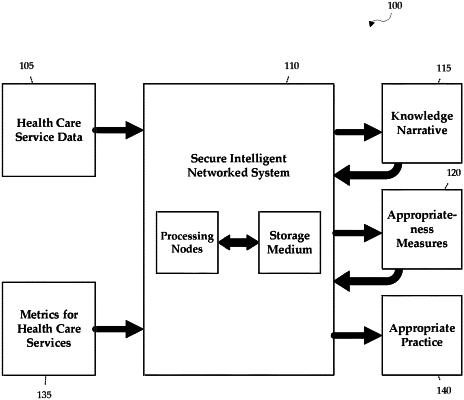| CPC G16H 40/20 (2018.01) | 21 Claims |

|
1. An intelligent secure networked system for identifying and correcting a defect in a health care service, the system comprising:
a computer processor for processing data;
a storage medium communicatively coupled to the computer processor, the storage medium storing data;
a secure intelligent network communicatively coupled to the computer processor and the storage medium, the secure intelligent network having a deep neural network, the deep neural network trained by an evidence engine with evidentiary support including medical journals, health studies, clinical guidelines, or standards bodies, the deep neural network comprising:
a first input node configured to receive a set of data comprising physician-directed health care service data for a previous stress test as coded and unstructured narrative text, and health care service data as the health care service is being delivered, the first input node configured to adjust for a factor lacking in claims data including undocumented comorbidities, hedging in diagnostic uncertainty, strength of clinical support, ulterior motives, defensive medicine, a presence for each factor equating to incremental statistical variability that is calculated to a sum, added to a statistical range of better practice and results in an adjusted range of better practice;
a second input node configured to receive a set of metrics associated with appropriateness of a stress test;
a plurality of intermediary nodes, the plurality of intermediary nodes having a weight, bias and threshold directing an analysis by the deep neural network on the physician-directed health care service data for the stress test;
a first output node generating a first output comprising a knowledge narrative representing a plain-text description of an appropriateness measure for the stress test and a range of better practice comprising limits of the appropriateness measure, where an appropriateness measures score exceeds an upper limit in a case of overuse of a service, or is below a lower limit in a case of underuse of a service that results from operation of the deep neural network on input elements;
a second output node generating a second output that comprises a rate of inappropriateness of the stress test, the inappropriateness having a numerator representing a number of stress tests with nuclear imaging that occurred within thirty days of the evaluation and management visit to the cardiologist and having a denominator representing stress testing that occurred within thirty days of the evaluation and management visit to the cardiologist, excluding cases with inpatients, outpatients with symptoms of acute coronary syndrome or patients who had a cardiac-related emergency department visit within a thirty day period;
a dynamic feedback communicatively coupling the knowledge narrative and range of better practice node and the rate of inappropriateness of the stress test for the health care service for continuous learning of the deep neural network;
a third output node comprising the appropriateness measures score for cardiovascular stress testing; and
a fourth output node comprising a cumulative appropriateness practice score to reflect a physician's performance across multiple measures or practice areas.
|